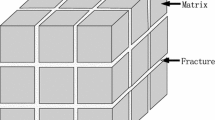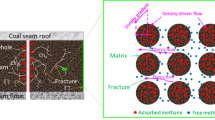Abstract
Gas sorption-induced coal deformation is one of the primary geomechanics effect in coalbed methane (CBM) engineering. Coal is known to have transversely isotropic properties because of its cleat structure. We propose a new theoretical approach to modeling the strain behavior of bulk coal by including sorption-induced matrix shrinkage/swelling strain, cleat volume strain and matrix mechanical strain resulting from changes in pore pressure, and external stresses. The new model framework can define the apparent bulk coal volume with respect to the variation in gas pressure. To validate the model, unconstrained gas flooding experiments were conducted with helium, methane and carbon dioxide injections. The experimental data agreed well with the modeled strain evolution results under hydrostatic conditions and at the injection pressure conditions. The results show that the degree of anisotropy is ~ 1.6 for helium injection, comparing the strains perpendicular to and parallel to the bedding plane. The results demonstrate that the volumetric strains closely correlate to the sorption capability of coal. The maximum volumetric strain induced by carbon dioxide injection can reach ~ 2.05% as gas pressure increases up to ~ 5.43 MPa, which is ~ 2.77 times that of the methane-induced volumetric strain of ~ 0.74% at a gas pressure of ~ 5.45 MPa. The proposed model can be simplified to be equivalent to the commonly extended Langmuir-type strain model at relatively low gas pressure for bulk coal with low cleat porosity. The proposed model can also successfully cover the volumetric response of bulk coal for high pressures that range beyond 13 MPa. A sensitivity study shows that Young’s modulus, Poisson’s ratio, and the degree of anisotropy affect the volumetric responses differently at various pressure stages, but the effects are always distinct for high-pressure injections. The proposed model framework can be coupled into a coal dynamic permeability model for defining the permeability evolution—which is important for gas production predictions for CBM wells.











Similar content being viewed by others
References
Adamson AW, Gast AP (1997) Physical chemistry of surfaces, 6th edn. Wiley, New York
Alcañiz-Monge J, Lozano-Castelló D, Cazorla-Amorós D, Linares-Solano A (2009) Fundamentals of methane adsorption in microporous carbons. Microporous Mesoporous Mater 124:110–116
Ammosov II, Eremin IV (1963) Fracturing in coal. IZDAT Publishers, Moscow. Office of Technical Services, Washington, DC, p 109
Bandyopadhyay K, Mallik J, Ghosh T (2020) Dependence of fluid flow on cleat aperture distribution and aperture-length scaling: a case study from Gondwana coal seams of Raniganj Formation, Eastern India. Int J Coal Sci Technol 7(1):133–146
Bangham DH, Fakhoury NJ (1931) The translation motion of molecules in the adsorbed phase on solids. J Chem Soc 1324–1333
Cheng Y, Jiang H, Zhang X, Cui J, Song C, Li X (2017) Effects of coal rank on physicochemical properties of coal and on methane adsorption. Int J Coal Sci Technol 4(2):129–146
Cui X, Bustin RM (2005) Volumetric strain associated with methane desorption and its impact on coalbed gas production from deep coal seams. Am Assoc Pet Geol Bull 89:1181–1202
Day S, Fry R, Sakurovs R (2008) Swelling of Australian coals in supercritical CO2. Int J Coal Geol 74:41–52
Espinoza DN, Vandamme M, Dangla P, Pereira J (2013) A transverse isotropic model for microporous solids: application to coal matrix adsorption and swelling. J Geophys Res Solid Earth 118:6113–6123
Everett DH, Koopal LK (2001) Definitions, terminology and symbols in colloid and surface chemistry. Int Union Pure Appl Chem 16–26
Goodman RE (1989) Introduction to rock mechanics, 2nd edn. Wiley, New York
Gu F, Chalaturnyk R (2010) Permeability and porosity models considering anisotropy and discontinuity of coalbeds and application in coupled simulation. J Pet Sci Eng 74:113–131
Harpalani S, Mitra A (2010) Impact of CO2 injection on flow behavior of coalbed methane reservoirs. Transp Porous Media 82:141–156
Harpalani S, Schraufnagel RA (1990) Shrinkage of coal matrix with release of gas and its impact on permeability of coal. Fuel 69:551–556
Harpalani SG (1995) Estimation of changes in fracture porosity of coal with gas emission. Fuel 74:1491–1498
Hofer H (1915) Schwundspalten (Schlechten, Lassen). Shrinkage cracks (cleats, separations). Mitt Geol Ges Wien 7(1 and 2)
Hol S, Spiers CJ (2012) Competition between adsorption-induced swelling and elastic compression of coal at CO2 pressures up to 100 MPa. J Mech Phys Solids 60(11):1862–1882
Jaeger GC (1969) Fundamentals of rock mechanics. Chapman and Hall Ltd and Science Paperbacks, London
Kaiser E (1908) Erlaetergunen zur geol. Blatt Bruehe, Karte von Preussen, p 44
Karacan CÖ (2003) Heterogeneous sorption and swelling in a confined and stressed coal during CO2 injection. Energy Fuels 17(6):1595–1608
Karacan CÖ (2007) Swelling-induced volumetric strains internal to a stressed coal associated with CO2 sorption. Int J Coal Geol 72:209–220
Kulander BR, Dean SL (1993) Coal-cleat domains and domain boundaries in the Allegheny Plateau of West Virginia. Am Assoc Pet Geol Bull 77:1374–1388
Langmuir I (1917) The constitution and fundamental properties of solids and liquids. I. Solids. J Am Chem Soc 39:1848–1906
Laubach SE, Marrett RA, Olson IE, Scott AR (1998) Characteristics and origins of coal cleat: a review. Int J Coal Geol 35:175–207
Levine JR (1996) Model study of the influence of matrix shrinkage on absolute permeability of coal bed reservoirs. Geol Soc Spec Publ 109:197–212
Liu A, Wang K, Zang J, Du F, Zhou AT (2018) Relative permeability of gas for unconventional reservoirs. Transp Porous Media 124:289–307
Liu J, Chen Z, Elsworth D, Qu H, Chen D (2011) Interactions of multiple processes during CBM extraction: a critical review. Int J Coal Geol 87:175–189
Liu J, Peach CJ, Spiers CJ (2016a) Anisotropic swelling behaviour of coal matrix cubes exposed to water vapour: effects of relative humidity and sample size. Int J Coal Geol 167:119–135
Liu J, Fokker PA, Spiers CJ (2017) Coupling of swelling, internal stress evolution, and diffusion in coal matrix material during exposure to methane. J Geophys Res Solid Earth 122:844–865
Liu S, Harpalani S (2014a) Determination of the effective stress law for deformation in coalbed methane reservoirs. Rock Mech Rock Eng 47:1809–1820
Liu S, Harpalani S (2014b) Compressibility of sorptive porous media: part 1. Background and theory. Am Assoc Pet Geol Bull 98:1761–1772
Liu S, Harpalani S (2013) A new theoretical approach to model sorption-induced coal shrinkage or swelling. Am Assoc Pet Geol Bull 97:1033–1049
Liu S, Wang Y, Harpalani S (2016) Anisotropy characteristics of coal shrinkage/swelling and its impact on coal permeability evolution with CO2 injection Greenh Gases. Sci Technol 6:615–632
Liu X, Liu C, Liu G (2019) Dynamic behavior of coalbed methane flow along the annulus of single-phase production. Int J Coal Sci Technol 6(4):547–555
Ma Q, Harpalani S, Liu S (2011) A simplified permeability model for coalbed methane reservoirs based on matchstick strain and constant volume theory. Int J Coal Geol 85:43–48
Maggs FAP (1946) The adsorption-swelling of several carbonaceous solids. Trans Faraday Soc 42:284–288
Mitra A, Harpalani S, Liu S (2012) Laboratory measurement and modeling of coal permeability with continued methane production: part 2—modeling results. Fuel 94:117–124
Moore ES (1932) Coal, its properties, analysis, classification, geology, extraction, uses, and distribution. Wiley, New York
Moffat DH, Weale KE (1955) Sorption by coal of methane at high pressure. Fuel 34:449–462
Moore R, America BP, Company P et al (2014) Anisotropic model for permeability change in coalbed methane wells. In: Proceedings of the society of petroleum engineers, 17–18th April, Denver, Colorado, SPE-169592-MS,16–18
Palmer I, Mansoori J (1998) How permeability depends on stress and pore pressure in coalbeds: a new model. SPE Reserv Eval Eng 1:539–544
Pan Z, Connell LD (2011) Modelling of anisotropic coal swelling and its impact on permeability behaviour for primary and enhanced coalbed methane recovery. Int J Coal Geol 85:257–267
Pan Z, Connell LD (2007) A theoretical model for gas adsorption-induced coal swelling. Int J Coal Geol 69:243–252
Pone JDN, Hile M, Halleck PM, Mathews JP (2009) Three-dimensional carbon dioxide-induced strain distribution within a confined bituminous coal. Int J Coal Geol 77:103–108
Raistrick A, Marshall CE (1947) The nature and origin of coal and coal seams. The English University Press Ltd., London
Reiss LH (1980) The reservoir engineering aspects of fractured formations. Gulf Publishing Co., Houston
Sang G, Elsworth D, Liu S, Harpalani S (2017) Characterization of swelling modulus and effective stress coefficient accommodating sorption-induced swelling in coal. Energy Fuels 31:8843–8851
Saurabh S, Harpalani S, Singh VK (2016) Implications of stress re-distribution and rock failure with continued gas depletion in coalbed methane reservoirs. Int J Coal Geol 162:183–192
Saurabh S, Harpalani S (2018) The effective stress law for stress-sensitive transversely isotropic rocks. Int J Rock Mech Min Sci 101:69–77
Saurabh S, Harpalani S (2019) Anisotropy of coal at various scales and its variation with sorption. Int J Coal Geol 201:14–25
Seidle JP, Jeansonne MW, Erickson DJ (1992) Application of matchstick geometry to stress dependent permeability in coals. Society of Petroleum Engineers, Casper, Wyoming, pp 433–444
Shi JQ, Durucan S (2006) A model for changes in coalbed permeability during primary and enhanced methane recovery. SPE Reserv Eval Eng 8:291–299
Shi JQ, Durucan S (2004) Drawdown induced changes in permeability of coalbeds: a new interpretation of the reservoir response to primary recovery. Transp Porous Media 56:1–16
US.EIA (2009) Natural gas gross withdrawals and production. US Energy Information Administration, Washington
US.EIA (2013) Natural gas gross withdrawals and production. US Energy Information Administration, Washington
Wang G, Jiang C, Shen J et al (2019) Deformation and water transport behaviors study of heterogenous coal using CT-based 3D simulation. Int J Coal Geol 211:103204
Wang G, Qin X, Shen J et al (2019) Quantitative analysis of microscopic structure and gas seepage characteristics of low-rank coal based on CT three-dimensional reconstruction of CT images and fractal theory. Fuel 256:115900
Wang K, Liu A, Zhou A (2017) Theoretical analysis of influencing factors on resistance in the process of gas migration in coal seams. Int J Min Sci Technol 27:315–319
Wu C, Yuan C, Wen G, Han L, Liu H (2020) A dynamic evaluation technique for assessing gas output from coal seams during commingling production within a coalbed methane well: a case study from the Qinshui Basin. Int J Coal Sci Technol 7(1):122–132
Zimmerman RW (1991) Compressibility of sandstones. Elsevier, New York
Author information
Authors and Affiliations
Corresponding author
Ethics declarations
Conflict of Interest
The authors declare no conflict of interest for this manuscript.
Additional information
Publisher's Note
Springer Nature remains neutral with regard to jurisdictional claims in published maps and institutional affiliations.
Rights and permissions
About this article
Cite this article
Liu, A., Liu, S., Wang, G. et al. Modeling of Coal Matrix Apparent Strains for Sorbing Gases Using a Transversely Isotropic Approach. Rock Mech Rock Eng 53, 4163–4181 (2020). https://doi.org/10.1007/s00603-020-02159-3
Received:
Accepted:
Published:
Issue Date:
DOI: https://doi.org/10.1007/s00603-020-02159-3




